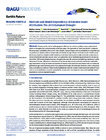Methods and Model Dependency of Extreme Event Attribution: The 2015 European Drought
Abstract
Science on the role of anthropogenic influence on extreme weather events, such as heatwaves or droughts, has evolved rapidly in the past years. The approach of “event attribution” compares the occurrence-probability of an event in the present, factual climate with its probability in a hypothetical, counterfactual climate without human-induced climate change. Several methods can be used for event attribution, based on climate model simulations and observations, and usually researchers only assess a subset of methods and data sources. Here, we explore the role of methodological choices for the attribution of the 2015 meteorological summer drought in Europe. We present contradicting conclusions on the relevance of human influence as a function of the chosen data source and event attribution methodology. Assessments using the maximum number of models and counterfactual climates with pre-industrial greenhouse gas concentrations point to an enhanced drought risk in Europe. However, other evaluations show contradictory evidence. These results highlight the need for a multi-model and multi-method framework in event attribution research, especially for events with a low signal-to-noise ratio and high model dependency such as regional droughts. Show more
Permanent link
https://doi.org/10.3929/ethz-b-000212504Publication status
publishedExternal links
Journal / series
Earth's FutureVolume
Pages / Article No.
Publisher
WileySubject
Event attribution; 2015 European drought; climate changeOrganisational unit
03778 - Seneviratne, Sonia / Seneviratne, Sonia
More
Show all metadata





